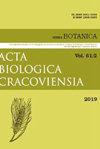Comparative anatomy of ovules in Galinsoga, Solidago and Ratibida (Asteraceae)
IF 0.5
4区 生物学
Q4 PLANT SCIENCES
引用次数: 16
Abstract
Many Asteraceae species have been introduced into horticulture as ornamental or interesting exotic plants. Some of them, including Solidago and Galinsoga , are now aggressive weeds; others such as Ratibida are not. Special modifications of the ovule tissue and the occurrence of nutritive tissue have been described in several Asteraceae species, including invasive Taraxacum species. This study examined whether such modifications might also occur in other genera. We found that the three genera examined – Galinsoga ( G. quadriradiata ), Solidago ( S. canadensis , S. rigida , S. gigantea ) and Ratibida ( R. pinnata ) – differed in their nutritive tissue structure. According to changes in the integument, we identified three types of ovules in Asteraceae: “Taraxacum” type (recorded in Taraxacum , Bellis , Solidago , Chondrilla ), with well-developed nutritive tissue having very swollen cell walls of spongy structure; “Galinsoga” type (in Galinsoga ), in which the nutritive tissue cells have more cyto- plasm and thicker cell walls than the other integument parenchyma cells, and in which the most prominent character of the nutritive tissue cells is well-developed rough ER; and “Ratibida” type (in Ratibida ), in which the nutritive tissue is only slightly developed and consists of large highly vacuolated cells. Our study and future investigations of ovule structure may be useful in phylogenetic analyses.菊科黄花、黄花和凤仙花胚珠的比较解剖
许多菊科植物已作为观赏或有趣的外来植物引入园艺。其中一些,包括一枝黄花和加林索加,现在是侵略性极强的杂草;其他如Ratibida则不是。在一些菊科物种中,包括入侵的蒲公英,已经描述了胚珠组织的特殊修饰和营养组织的发生。这项研究调查了这种修饰是否也可能发生在其他属中。研究发现,加林果属(G. quadriradiata)、Solidago属(S. canadensis、S. rigida、S. gigantea)和Ratibida属(R. pinnata)在营养组织结构上存在差异。根据被膜的变化,我们将菊科植物的胚珠分为三种类型:“Taraxacum”型(记录于Taraxacum, Bellis, Solidago, Chondrilla),其营养组织发育良好,细胞壁肿胀,呈海绵状结构;“Galinsoga”型(以下简称Galinsoga),其营养组织细胞比其他被壁薄壁细胞细胞质多,细胞壁厚,其最突出的特征是发育良好的粗质内质网;和" Ratibida "型(在Ratibida中),其中营养组织仅轻微发育,由大的高度液泡化的细胞组成。我们的研究和未来对胚珠结构的研究可能有助于系统发育分析。
本文章由计算机程序翻译,如有差异,请以英文原文为准。
求助全文
约1分钟内获得全文
求助全文
来源期刊
CiteScore
3.00
自引率
0.00%
发文量
0
审稿时长
>12 weeks
期刊介绍:
ACTA BIOLOGICA CRACOVIENSIA Series Botanica is an English-language journal founded in 1958, devoted to plant anatomy and morphology, cytology, genetics, embryology, tissue culture, physiology, biochemistry, biosystematics, molecular phylogenetics and phylogeography, as well as phytochemistry. It is published twice a year.

 求助内容:
求助内容: 应助结果提醒方式:
应助结果提醒方式:


